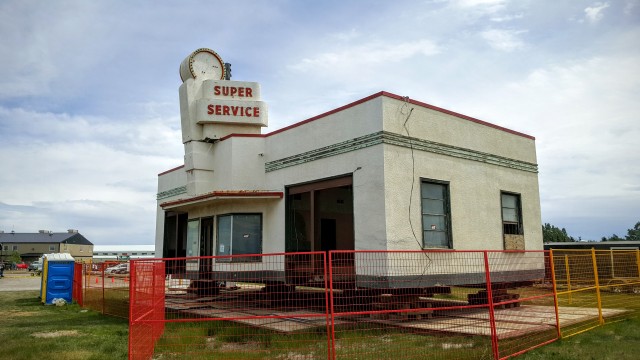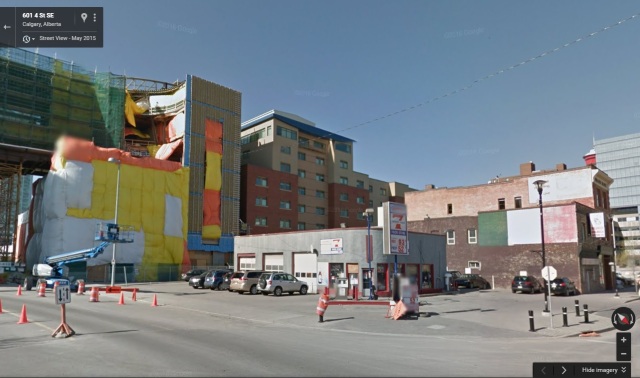“You know the place, even if you never actually purchased fuel from its two outdated pumps, or bought coffee or lottery tickets over the counter inside.” — Michael Platt, Calgary Sun
It is a story we see play out again and again when it comes to historical preservation. A piece of our past is put up for sale and purchased by a developer with a vision for something bigger, better, newer. Some will come forward and argue for preservation or re purposing, while others will chant “Progress!”.
When you’re making the case for preservation, it’s a fight you will almost always lose. Dollars and sense are all that matter in today’s world. Try and find an investor who would be willing to spend the money on remediation of the site, of renovating the building, of trying to start some sort of small business — good luck. That’s a lot of investment with little return on a large amount of risk. But, find someone with the money to knock it down and build another generic highrise? No problem. After all, high priced condos over main floor retail? That’s a recipe for making money. And, it can all be done in the name of urban revitalization too!
And, when that little nondescript building you want to see saved is a gas station in Calgary? Forget it. First of all, gas stations are used for cars and today Calgary is all about trying to shed its image as a car capital. We’re actively taking away lanes from cars and giving them to bicycles. We’re intentionally making fewer and fewer places to park. Cars are evil now.

Eamon’s Service Station – June 10, 1956 http://ww2.glenbow.org/dbimages/arcpa/2/g/pa-3837-24.jpg
Second, Calgary will live with the legacy of the Eamon’s Service Station fiasco for many years to come. For those who need a refresher, Eamon’s was a local landmark located on the old highway (now the 1A) between Calgary and Banff. It was your typical postwar roadside oasis, complete with gas station, restaurant, and cabins. It was Calgary’s own little Route 66 style stopping place.
When the City needed the land to build the Tuscany light rail transit (LRT) station, they tried to do the right thing. They purchased the sign and the gas station building and put them into storage, and then waited for an entrepreneur type to come along with a grand vision. Convert the station into a small cafe or coffee house and then re-open it near the original site. Sounds perfect, right? Morning commuters could grab a coffee and a muffin on their way to the train and we preserved the history of this local icon in a useful and meaningful way.
It never happened. No one came forward with cash and a viable plan.
So, the little service station continued to sit in storage, costing Calgary taxpayers money every month.
Sure, the City eventually took the historic sign and put in close to the original location in the parking lot of the new train station. It stands there today as an out-of-context stark reminder of what was there.
The building was eventually sold to a car club in High River, AB for $10 and moved to their grounds where it sits awaiting restoration. It will be many years before local preservationists will escape the shadow of the Eamon’s legacy. It cost the City of Calgary a lot of money to try and do the right thing.

Eamon’s Service Station – June 18, 2016 High River, AB
So, it should come as no surprise that no local politician would dare even suggest doing something to re purpose the little 1952 gas station sitting at the corner of 8th Avenue and 4th Street SE. It would be career suicide to suggest anything other than “Tear it down and build something shiny.”

Can Pro Gas and Propane Image from Google Street View (May 2015)
It doesn’t look like much. It’s small and very typical for service stations of that period. One rounded corner where the main entrance is located, some service bays, and a couple of pumps sitting diagonally relative to the street. The owners, having held out for a number of years even as the entire neighborhood around them underwent massive changes, finally deciding it is time to move on.
Perhaps the oldest service station in the city, it is representative of a different era. Service stations have undergone a lot of change. Now “service” is a bit of a misnomer. Pull up to the pump, insert your card, get your gas, and move on. You don’t even need to see another human in order to get your fuel anymore. Long gone are the days when a uniformed attendant would appear as you rolled to a stop, start filling your tank, checking your oil, and cleaning your windows.
Our relationships with service stations have changed. They once represented the freedom of travel that came with the era following World War II. They meant something; they were special places. None of this really occurred to me until I started doing an online search of the Glenbow Archives. I was hoping to find an image of this little service station when it was new and known as the “Transport Service Centre”.
My first search using the subject “Automobiles – Service stations” with keyword “Calgary” was limited to the years 1950 – 1959. It returned 79 results, mostly of Imperial Oil / Esso stations. (As a side note, Esso seemed to do the best job of capturing their stations.) None of the images I found contained the doomed gas station which is the subject of this post, however.
Changing the search parameters to focus on the years 1960 – 1969 and now there are only 34 images found, less than half of what there were from the 1950s. Change the years to be from 1970 – 1979 and suddenly there are only four images returned. This sudden and rapid decrease in the historical record reflects our changing attitude. Service stations were no seen as vital stopping points as we explored our continent on summer vacations but were rather just another piece of infrastructure and certainly not worth capturing on film.
Of course, I wouldn’t want this article to be a complete downer, so I’ll mention some success stories when it comes to old service stations. Re-purposing can be done successfully, just perhaps not in Calgary and not right now.
First, Big John’s Texas BBQ in Page, Arizona is a restaurant operating out of an old service station.

Big John’s BBQ — Page, Arizona Image from Google Street View


A big Amen to all you said. I forgot about that little gas station down by the Louis – might have check it out before it’s gone. That neighbouhood is gentrifying nicely (spoken in a sarcastic tone). I remember when this part of Calgary was rough and gritty…and fabulous.
LikeLike
Well written post. You really need to write and post more.
LikeLiked by 1 person
Thank you for the words of encouragement. You would think that being unemployed would mean I have more free time to dedicate to the blog, but that just doesn’t seem to be happening. I really would like to post more often — maybe that will be a goal for 2017. Cheers!
LikeLike
Pingback: Big Loss in Tiny Orion | DanOCan
Pingback: 2016 In Review: Explorations, Visitations, and Tribulations (Part 1) | DanOCan
Hi Dan
I was recently told about the existence of a gas station at the north-east corner of John Laurie Blvd. & Shaganappi Trail North. While it’s long gone now, it would have been located at the furthermost south-west corner of present-day Nose Hill Park. I moved into the Edgemont area 20 years ago, and find learning about our local history fascinating.
I came across your article while reading about the fate of the old Transport Service Centre in the East Village. I’m glad there’s people like you who’ll take the time to record these memories for future generations.
Would you be able to shed any light on the Nose Hill Park gas station for me?
Cheers,
Bill
LikeLike
I did some quick digging. I found someone who posted this map of Calgary from circa 1975. https://www.flickr.com/photos/ferreth/6239653896/sizes/l No sign of the gas station there, but it interesting to see how John Laurie turned into Shaganappi at that time. I’m afraid I don’t know anything else about it, but it sounds most interesting.
LikeLike